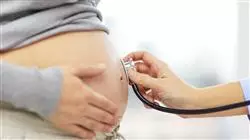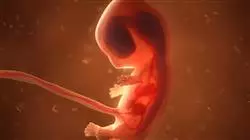University certificate
The world's largest faculty of nursing”
Introduction to the Program
The most comprehensive training in Main Hemorrhagic Problems During Pregnancy. Obstetric Accidents and Fetal Problems for Midwives, from the entire teaching market: a wide and complete Postgraduate diploma, unique in its specialty"

As midwives, our knowledge of first trimester pathology is sometimes limited by the fact that most of us are dedicated to labor and delivery units, forgetting that women who come to the emergency department are susceptible to pathologies and complications at any time during pregnancy.
The first trimester is fundamental in the subsequent fetal and consequently neonatal development with which midwives will work throughout pregnancy, delivery and puerperium.
Having comprehensive knowledge will bring safety and scientific rigor to
Most of the problems derived from placenta, amniotic fluid and obstetric accidents are usually of an emergent nature. Up to date knowledge of them can completely change the obstetric and neonatal outcome.
The second part of this Postgraduate diploma will include the bibliographic review of the most up to date protocols on the above mentioned topics.
Their knowledge will also help practitioners to anticipate urgent situations, being able to prevent and/or predict them, since the risk factors of each of the problems will also be included in detail in order to facilitate the student's learning of them.
This module is another one that houses chapters that midwives work with on a daily basis.
More than 25% of neonates are born by instrumental delivery or cesarean section, so the best references will be incorporated here so that the student can make an exhaustive study of them and incorporate new and integrated knowledge.
Topics such as labor inductions and premature rupture of membranes, chapters in constant revision and change of protocols thanks to new studies and reviews, are also incorporated.
The positive Streptococcus B in gestational screening and its treatment will also be studied, another area in which midwives must be fully trained, since they are the ones who administer the medication, take samples and receive the pregnant woman in the emergency units.
Get a complete and proper qualification in Postgraduate diploma in Main Hemorrhagic Problems During Pregnancy. Obstetric Accidents and Fetal Problems for Midwives, with this highly effective Postgraduate diploma and open new paths to your professional progress"
This Postgraduate diploma in Main Hemorrhagic Problems During Pregnancy. Obstetric Accidents and Fetal Problems for Midwives offers you the characteristics of a Postgraduate Certificate of high scientific, teaching and technological level. These are some of its most notable features:
- Latest technology in online teaching software
- A highly visual teaching system, supported by graphic and schematic contents that are easy to assimilate and understand
- Practical cases presented by practising experts
- State-of-the-art interactive video systems
- Teaching supported by telepractice
- Continuous updating and recycling systems
- Self-regulating learning: full compatibility with other occupations
- Practical exercises for self-evaluation and learning verification
- Support groups and educational synergies: questions to the expert, debate and knowledge forums
- Communication with the teacher and individual reflection work
- Availability of content from any fixed or portable device with internet connection
- Libaries of complementary documentation permanently available, even after the course
Get a complete and proper qualification in Postgraduate diploma in Main Hemorrhagic Problems During Pregnancy. Obstetric Accidents and Fetal Problems for Midwives, with this highly effective Postgraduate diploma and open new paths to your professional progress"
Our teaching staff is made up of professionals from different fields related to this specialty. In this way, we ensure that we provide you with the training update we are aiming for. A multidisciplinary team of professionals trained and experienced in different environments, who will cover the theoretical knowledge in an efficient way, but, above all, will put the practical knowledge derived from their own experience at the service of the course: one of the differential qualities of this course.
This mastery of the subject matter is complemented by the effectiveness of the methodological design of this Postgraduate diploma in Main Hemorrhagic Problems During Pregnancy. Obstetric Accidents and Fetal Problems for Midwives, developed by a multidisciplinary team of e-learning experts, integrates the latest advances in educational technology. This way, you will be able to study with a range of comfortable and versatile multimedia tools that will give you the operability you need in your training.
The design of this program is based on Problem-Based Learning: an approach that conceives learning as a highly practical process. To achieve this remotely, we will use telepractice: with the help of an innovative interactive video system, and learning from an expert, you will be able to acquire the knowledge as if you were actually dealing with the scenario you are learning about. A concept that will allow you to integrate and fix learning in a more realistic and permanent way.
A Postgraduate diploma that will enable you to face the most complex situations in the area of Main Hemorrhagic Problems During Pregnancy. Obstetric Accidents and Fetal Problems for Midwives, with the expertise of a top practitioner”

The experience of specialized professionals who will contribute to the course with their expertise, will make this training a unique opportunity for professional growth"
Syllabus
The contents of this Postgraduate diploma have been developed by the different experts on this course with a clear purpose: to ensure that our students acquire each and every one of the necessary skills to become true experts in this field.
A complete and well-structured program that will take you to the highest standards of quality and success.

A comprehensive teaching program, structured in well-developed teaching units, oriented towards learning that is compatible with your personal and professional life"
Module 1. Concept of Gestational Risk, First Trimester Hemorrhage. Congenital Fetal Defects. Prenatal Diagnosis
1.1. Addressing High-risk Pregnancies. Definition of Risk Pregnancy. Risk Groups in Pregnant Women: Sociodemographic, Reproductive, Medical and Current Pregnancy. (The last 3 sections will be developed throughout the modules of the master's degree)
1.1.1. Socio-demographic Risk
1.1.1.1. Adolescent Pregnancy. Special Considerations
1.1.1.2. Mothers with Drug Dependency Problems
1.1.1.2.1. Principles of Drug-Induced Teratogenesis
1.1.1.2.2. Alcohol
1.1.1.2.3. Cocaine
1.1.1.2.4. Heroin
1.1.1.2.5. Other drugs: Marijuana, Cannabis
1.1.2. Occupational Risk in Pregnancy. Ergonomics. Radiation Exposure
1.1.3. Risks to Reproductive Health. (broken down throughout the course)
1.1.4. Current Gestation Risk.(broken down throughout the Postgraduate Certificate)
1.1.5. Medical Risk.(broken down throughout the course)
1.2. Miscarriage
1.2.1. Definition and Epidemiology
1.2.2. Main Causes of Miscarriage
1.2.3. Clinical Forms of Abortion
1.2.3.1. Threat of Abortion
1.2.3.2. Abortion in Progress
1.2.3.3. Complete Abortion
1.2.3.4. Incomplete Abortion
1.2.3.5. Deferred Abortion
1.2.3.6. Repeated Abortions: Concept and Approach
1.2.4. Diagnosis
1.2.4.1. Anamnesis
1.2.4.2. Physical Examination
1.2.4.3. Ultrasound
1.2.4.4. Determination of B-hCG
1.2.5. Treatment of Spontaneous Abortion
1.2.5.1. Medical Treatment
1.2.5.2. Surgical Treatment
1.2.6. Complications
1.2.6.1. Sepsis or Septic Abortion
1.2.6.2. Hemorrhage and Disseminated Intravascular Coagulation (DIC)
1.2.7. Postabortion Care
1.3. Ectopic or Extrauterine Pregnancy
1.3.1. Definition and Risk Factors
1.3.2. Clinical Presentation
1.3.3. Clinical and Ultrasound Diagnosis
1.3.3. Types of Extrauterine Gestation: Tubal, Ovarian, Abdominal, etc.
1.3.4. Therapeutic Management and Aftercare
1.4. Gestational Trophoblastic Disease:
1.4.1. Concept
1.4.2. Clinical forms of Hydatidiform Mole
1.4.2.1. Partial Mole
1.4.2.2. Complete Mole
1.4.3. Clinical forms of Trophoblastic Neoplasia
1.4.3.1. Invasive Mole and Placental Bed Tumor
1.4.3.2. Choriocarcinoma
1.4.4. Clinical and Ultrasound Diagnosis
1.4.5. Treatment
1.4.6. Aftercare and Complications
1.5. Congenital fetal defects due to genetic causes
1.5.1. Types of Chromosome Abnormalities
1.5.1.1. Aneuploidies
1.5.1.2. Structural Abnormalities
1.5.1.3. Sexrelated Disorders
1.5.2. Prenatal Diagnostic Techniques. Inclusion Criteria
1.5.2.1. Invasive Techniques
1.5.2.2. Non-Invasive Techniques
1.5.3. Genetic Counseling
1.6. Congenital Fetal Defects Secondary to Infections: TORCH
1.6.1. Toxoplasma
1.6.1.1. Etiologic Agent, Clinic and Epidemiology
1.6.1.2. Prevention
1.6.1.3. Diagnosis
1.6.1.4. Treatment
1.6.1.5. Congenital Toxoplasma Infection
1.6.2. Rubella
1.6.2.1. Etiologic Agent, Clinic and Epidemiology
1.6.2.2. Prevention and Vaccination
1.6.2.3. Diagnosis
1.6.2.4. Treatment
1.6.2.5. Congenital rubella infection
1.7. Congenital Fetal Defects Secondary to Infections: TORCH
1.7.1. Cytomegalovirus
1.7.1.1. Etiologic Agent, Clinic and Epidemiology
1.7.1.2. Prevention
1.7.1.3. Diagnosis
1.7.1.4. Treatment
1.7.1.5. Congenital Cytomegalovirus Infection
1.7.2. Chickenpox
1.7.2.1. Etiologic Agent, Clinic and Epidemiology
1.7.2.2. Prevention and Vaccination
1.7.2.3. Diagnosis
1.7.2.4. Treatment
1.7.2.5. Congenital Chickenpox Infection
1.7.2.6. Complications due to Chickenpox in Mothers
1.8. Congenital Fatal Defects Secondary to Infections: TORCH (III)
1.8.1. Herpes Simplex Virus
1.8.1.1. Etiologic Agent, Clinic and Epidemiology
1.8.1.2. Prevention
1.8.1.3. Diagnosis
1.8.1.4. Treatment
1.8.1.5. Congenital Herpes Simplex Infection
1.8.2. Syphilis
1.8.2.1. Etiologic Agent, Clinic and Epidemiology
1.8.2.2. Prevention
1.8.2.3. Diagnosis
1.8.2.4. Treatment
1.8.2.5. Sifilis Congenita
1.9. Other Infections that cause Fetal Problems
1.9.1. Parvovirus B19
1.9.1.1. Etiologic Agent, Clinic and Epidemiology
1.9.1.2. Prevention
1.9.1.3. Diagnosis
1.9.1.4. Treatment
1.9.1.5. Congenital parvovirus Infection
1.9.2. Listeria
1.9.2.1. Etiologic Agent, Clinic and Epidemiology
1.9.2.2. Prevention and Vaccination
1.9.2.3. Diagnosis
1.9.2.4. Treatment
1.9.2.5. Congenital Listeria Infection
1.10. HIV and Gestation
1.10.1. Epidemiology
1.10.2. Gestational Screening and Diagnosis
1.10.3. Clinical Management and Treatment
1.10.4. Delivery of an HIV-positive Woman
1.10.5. Neonatal Care and Vertical Infection
Module 2. Pathology of the Placenta and Fetal Appendages. Obstetric Accidents
2.1. Placenta Accrete
2.1.1. Definition and Forms of Placenta Accrete
2.1.1.1. Placenta Accreta
2.1.1.2. Placenta Increta
2.1.1.3. Placenta Percreta
2.1.2. Risk Factors
2.1.3. Morbimortality
2.1.4. Diagnosis
2.1.5. Clinical Management and Delivery of Pregnant Women with Placental Accreta
2.2. Placenta Previa
2.2.1. Concept
2.2.2. Classification
2.2.3. Risk Factors
2.2.4. Morbimortality
2.2.5. Diagnosis
2.2.6. Management of Gestation and Delivery of a Pregnant Woman with Placenta Previa
2.3. Placental Morphological and Functional Abnormalities
2.3.1. Size Alterations
2.3.2. Morphological Changes
2.3.2.1. Bilobed Placenta
2.3.2.2. Circumvallate Placenta
2.3.2.3. Placenta Succenturiata
2.3.2.4. Espuria
2.3.3. Placental Insufficiency
2.4. Umbilical Cord Anomalies
2.4.1. Variants of Umbilical Cord Length and its Complications: Knots
2.4.2. Umbilical Cord Anomalies in relation to Appearance
2.4.2.1. Procubitus
2.4.2.2. Laterocidence
2.4.2.3. Prolapses
2.4.2.3.1. Causes
2.4.2.3.2. Action to be taken in case of Cord Prolapse
2.4.3. Placental Insertion Abnormalities
2.4.3.1. Velamentous Insertion
2.4.3.2. Marginal Insertion
2.4.3.3. Previous Vasa
2.4.4. Vascular Anomalies
2.4.4.1. Thrombosis
2.4.4.2. Hematomas
2.4.4.3. The Single Umbilical Artery
2.5. Alterations of the Amniotic Membranes
2.5.1. Amnion Nodosum
2.5.2. Amniotic Bands
2.5.3. Extramembranous Pregnancy
2.5.4. Premature Rupture of Membranes and Chorioamnionitis (explained above)
2.6. Abnormalities of amniotic fluid
2.6.1. Default: Oligohydramnios and Anhydramnios
2.6.1.1. Concept and Epidemiology
2.6.1.2. Etiological Factors
2.6.1.3. Diagnosis
2.6.1.4. Effects on the Fetus and Neonate
2.6.1.5. Clinical Management and Treatment
2.6.2. In Excess: Polyhydramnios
2.6.2.1. Concept and Epidemiology
2.6.2.2. Etiological Factors
2.6.2.3. Diagnosis
2.6.2.4. Effects on the Fetus and Neonate
2.6.2.5. Clinical Management and Treatment. Delivery Assistance
2.7. Uterine Rupture
2.7.1. Concept
2.7.2. Types
2.7.3. Risk Factors
2.7.4. Clinical Diagnosis
2.7.5. Treatment
2.8. Premature Detachment of a Normally Positioned Placenta
2.8.1. Concept
2.8.2. Risk Factors
2.8.3. Clinical Diagnosis
2.8.4. Clinical Management
2.9. Amniotic Fluid Embolism
2.9.1. Concept
2.9.2. Risk Factors
2.9.3. Pathophysiology
2.9.4. Clinical Presentation
2.9.5. Diagnosis and Treatment
2.10. Shoulder Dystocia
2.10.1. Concept
2.10.2. Risk Factors
2.10.3. Diagnosis
2.10.4. Delivery Method in case of Placental Abruption
2.10.4.1. Primary Level Techniques
2.10.4.2. Secondary Level Techniques
2.10.4.3. Tertiary Level Techniques
2.10.5. Postnatal Care and Assessment
Module 3. Variations in Normal Delivery and the Onset of Labor. Mother Carrying Group B Streptococcus B
3.1. Instrumental Delivery
3.1.1. Concept
3.1.2. Indications
3.1.3. Contraindications
3.1.4. Criteria for using the Different Instruments
3.1.4.1. Forceps
3.1.4.2. Thierry Spatulas
3.1.4.3. Suction Cup
3.2. Breech Delivery
3.2.1. Concept
3.2.2. Classification
3.2.3. Etiology
3.2.4. Diagnosis
3.2.5. Vaginal Delivery Criteria and Management
3.3. Vaginal Delivery after Cesarean Section
3.3.1. Choice of Delivery Route
3.3.2. Contraindications for Vaginal Delivery with Previous Cesarean Section
3.3.3. Planned Cesarean
3.3.4. Labor Induction
3.4. Obstetric Anal Sphincter Injuries
3.4.1. Prevention
3.4.2. Classification
3.4.2.1. Third Degree Tear
3.4.2.2. Fourth Degree Tear
3.4.3. Reparation of Perineal Tears
3.4.4. Follow-up and Delivery after Anal Sphincter Injury
3.5. Cesarean Section
3.5.1. Indications
3.5.2. Classification
3.5.3. Cesarean Section Considerations
3.5.4. Surgical management
3.5.5. Post-Operative Care
3.6. External Cephalic Version
3.6.1. Concept
3.6.2. Indications
3.6.3. Contraindications
3.6.4. Complete Technique and Procedure
3.6.5. Complications
3.7. Cervical Ripening and Induction of Labor
3.7.1. Concept
3.7.2. Indications
3.7.3. Contraindications
3.7.4. Risks from Induction
3.7.5. Methods to Induce Labor
3.7.5.1. Pharmacological Methods
3.7.5.2. Non-Pharmacological Methods
3.8. Fetal Hydrops
3.8.1. Concept
3.8.1.1. Immune Hydrops
3.8.1.2. Non-Immune Hydrops
3.8.2. Pathophysiology
3.8.3. Diagnosis
3.8.4. Clinical Management
3.9. Mother Carrying Group B Streptococcus B(SGB)
3.9.1. Concept
3.9.2. Sample Collecting and Screening
3.9.3. Treatment
3.9.4. Management of Newborns of Mothers who are Carriers of GBS
3.10. Premature Rupture of Membranes
3.10.1. Etiology
3.10.2. Diagnosis
3.10.3. Preterm Premature Rupture of Membranes
3.10.4. Full-term Premature Rupture of Membranes

If your goal is to become a healthcare professional capable of communicating fluently in English, this program is for you"
Postgraduate Diploma in Main Hemorrhagic Problems during Pregnancy. Obstetric Accidents and Fetal Problems for Midwives.
Pregnancy pathology is one of the basic pillars of obstetrics and research. Numerous protocols have changed radically in recent years due to technological advances and new study results. With this complete Postgraduate Diploma in Major Hemorrhagic Problems during Pregnancy: Obstetric Accidents and Fetal Problems for TECH Midwives, the student will be able to incorporate the most updated knowledge in this area, considerably improving their capacity and efficiency of care. This program will cover topics such as the diagnosis and prevention of anemia in pregnancy, postpartum hemorrhage, uterine rupture, placental abruption, preeclampsia, ectopic pregnancy and the different types of abortion. In addition, techniques and procedures for the care and management of obstetric emergencies will be studied, such as cardiopulmonary resuscitation, manual removal of placenta, uterine suture, laparotomy and emergency fetal extraction. Another important aspect of the Postgraduate Diploma is the study of fetal problems and their management, such as intrauterine growth restriction, congenital defects and genetic problems, among others.
Specialize in our Postgraduate Diploma 100% online.
Upon completion of the Postgraduate Diploma in Major Hemorrhagic Problems during Gestation: Obstetric Accidents and Fetal Problems for Midwives, students will be highly trained to prevent, detect and manage major obstetric and fetal problems during gestation, which will allow them to provide comprehensive and quality care to patients and their newborns. If you are a midwife committed to the health care of women and their children during pregnancy and childbirth, this specialization is ideal for you. Don't miss the opportunity to specialize in one of the most important and challenging fields of maternal and fetal health. Enroll now in the Postgraduate Diploma in Major Hemorrhagic Problems during Pregnancy. Obstetric Accidents and Fetal Problems for Midwives!







